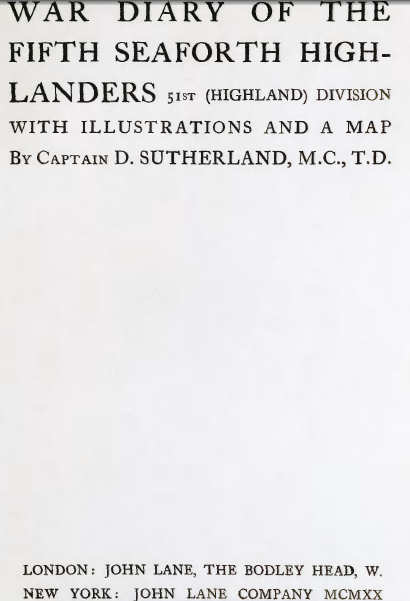
INTRODUCTORY
The 5th Seaforth Highlanders, whose war record is
given in this book, is the territorial Battalion of Caithness and
Sutherland, the two most northerly counties in Scotland.
The battalion was first formed in 1859, early in the
Volunteer movement, by the Duke of Sutherland and took as its badge, the
Sutherland Crest (the Wild Cat), with the proud motto "Sans Peur," while
its tartan was also the Sutherland, of black, navy blue, and green,
similar to that worn by the Argyll and Sutherland Highlanders.
At first confined to Sutherlandshire, it later
amalgamated with the Caithness Volunteers and was known as the 1st
Sutherland Highland Rifle Volunteers. It had a double justification for
its badge and tartan, for the 93rd (Sutherland) Highlanders were
recruited in 1801, during the Napoleonic Wars, in the same area, and had
the same badge and tartan, hence the battalion regards itself as the
lineal descendant of that famous unit.
When the Territorial Force was formed, the battalion
had to change its name to the 5th (Sutherland and Caithness) Seaforth
Highlanders, but as a concession to volunteer and county traditions, it
was still allowed to wear the Sutherland Badge and Tartan, and is thus
unique in being differently dressed from all other Seaforth Battalions.
On 5th August 1914 its mobilization, under Col. E. G.
Buik, V.D., took place, the various companies concentrating at Nigg on
the northern shore of the Cromarty Firth, whence, after a week spent in
digging trenches for the defence of the Admiralty Forts on the North
Sutor, it proceeded to Inverness. Thence, in a few days, it entrained
for Bedford, which became the training centre for the Highland
Territorial Division, afterwards so well known as the 51st.
For eight months the Division was billeted in this
town, and was treated with the utmost cordiality and kindness by the
townspeople, who did all they could to make their kilted invaders
comfortable and happy.
